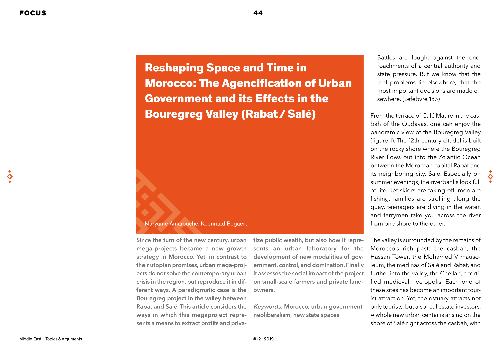Reshaping Space and Time in Morocco: The Agencification of Urban Government and its Effects in the Bouregreg Valley (Rabat/ Salé)
Since the turn of the new century, urban mega-projects became a new growth strategy in Morocco. Yet, in contrast to their utopian promises, urban mega-projects do not solve the contemporary urban crisis in the region, but reproduce it in different ways. A paradigmatic case is the Bouregreg project i...
I tiakina i:
| I whakaputaina i: | Middle East - Topics & Arguments |
|---|---|
| Ngā kaituhi matua: | , |
| Hōputu: | Artikel (Zeitschrift) |
| Reo: | Ingarihi |
| I whakaputaina: |
Philipps-Universität Marburg
2019
|
| Ngā marau: | |
| Urunga tuihono: | Urunga tuihono |
| Ngā Tūtohu: |
Kāore He Tūtohu, Me noho koe te mea tuatahi ki te tūtohu i tēnei pūkete!
|
| Whakarāpopototanga: | Since the turn of the new century, urban mega-projects became a new growth strategy in Morocco. Yet, in contrast to their utopian promises, urban mega-projects do not solve the contemporary urban crisis in the region, but reproduce it in different ways. A paradigmatic case is the Bouregreg project in the valley between Rabat and Salé. This article considers the ways in which this megaproject represents a means to extract profits and privatize public wealth, but also how it represents an urban laboratory for the development of new modalities of government, control, and domination. Finally it assesses the social impact of the project on small-scale farmers and private landowners. |
|---|---|
| DOI: | 10.17192/meta.2019.12.7934 |
